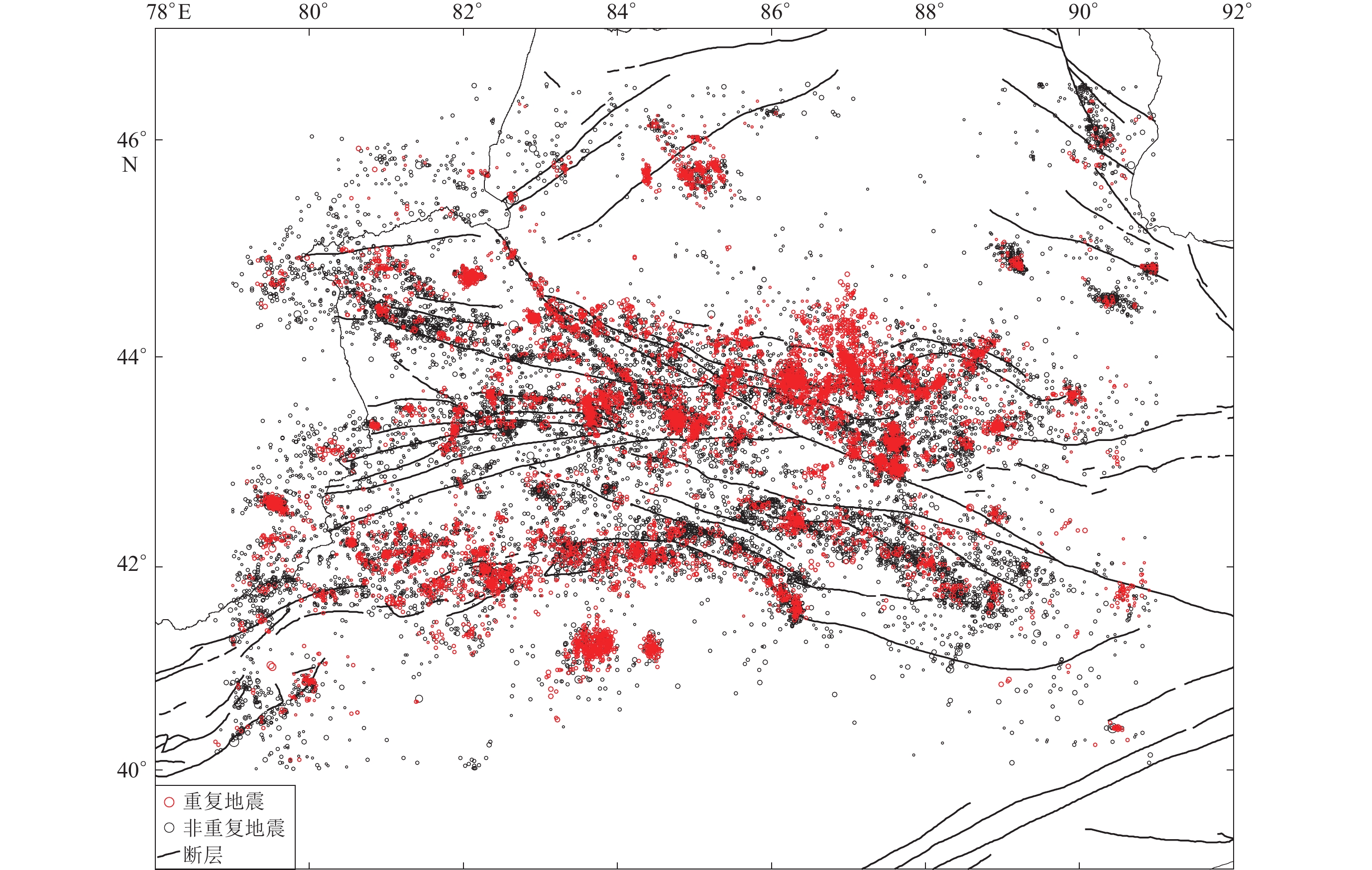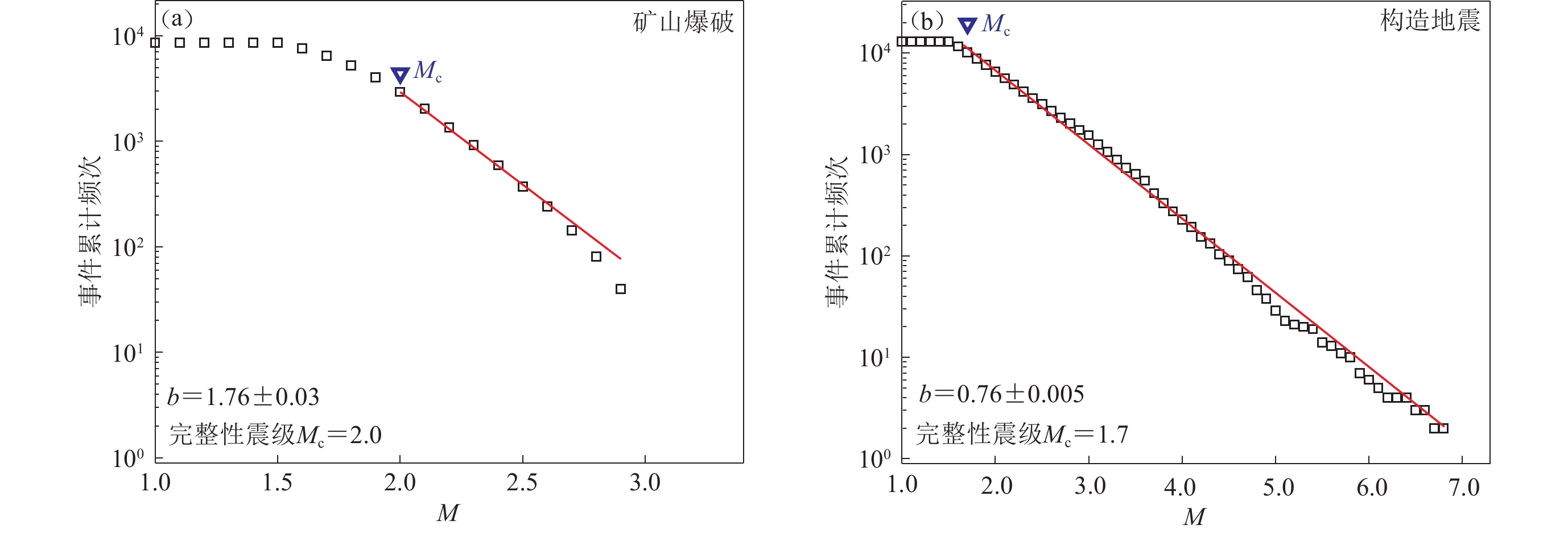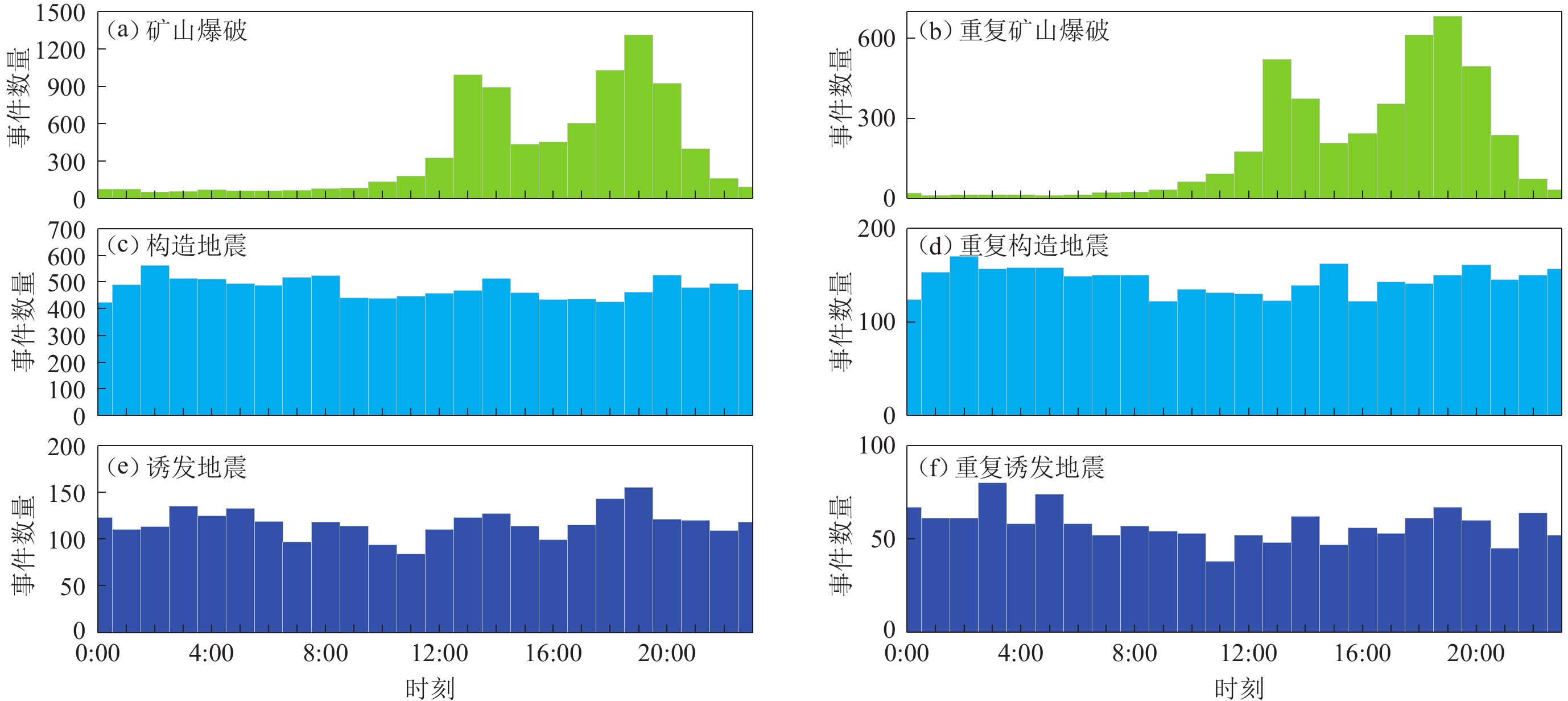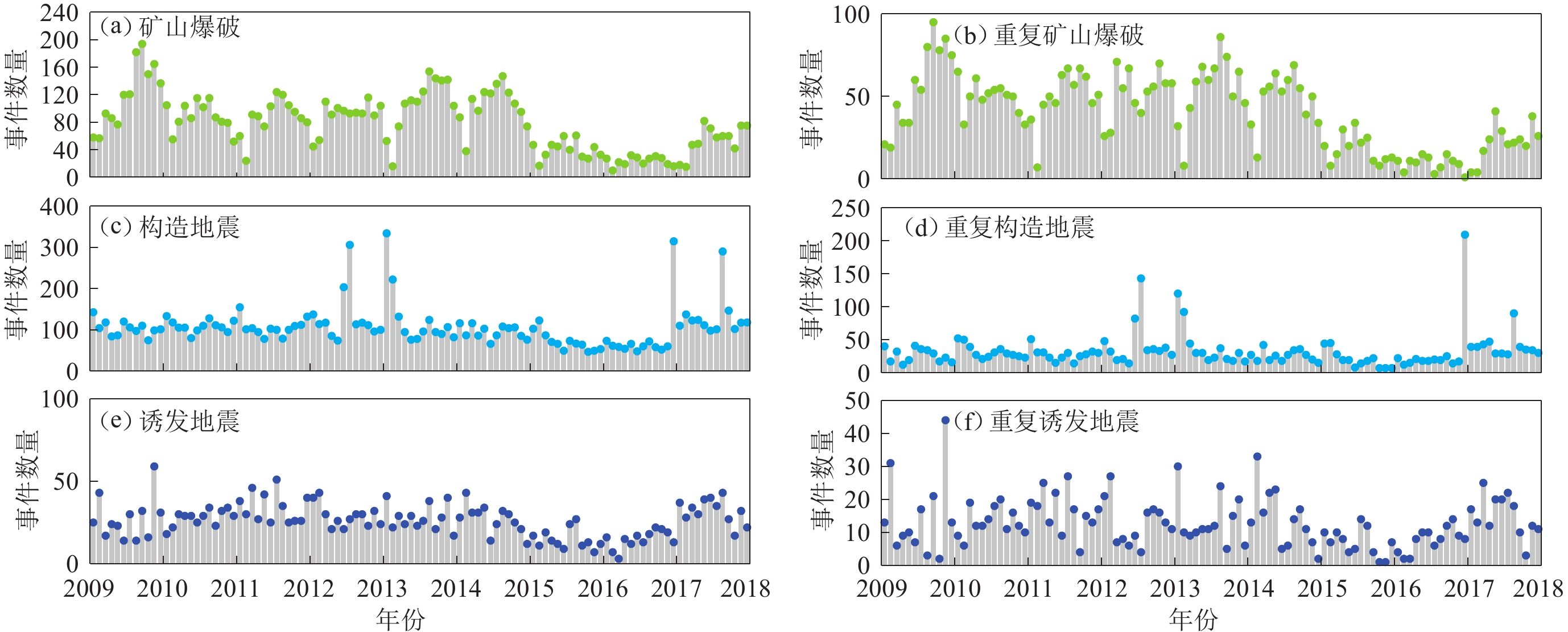Spatio-temporal characteristics of repeating seismic events in the middle of Tianshan orogenic belt
-
摘要: 基于2009—2017年新疆区域数字地震台网记录的地震波形数据,利用波形互相关技术及主事件定位方法识别并重新定位了新疆天山中段及其周缘的重复地震。以波形互相关系数0.9作为阈值来确定研究区的重复地震事件,统计结果显示3万零181个事件中的1万1 618个为重复地震事件,这些重复地震事件组成了2395组重复地震对和重复地震丛,占总事件数的38.5%。根据重复地震重定位前后地震对之间距离的统计结果推测,该区域的系统定位误差约为5—10 km。进一步结合该区域最新的震源分类结果对不同震源类型重复地震的时空分布特征予以分析,结果显示:重复矿山爆破事件在空间上呈丛集性分布,且其中的93.6%发生于白天,同时呈现季节性发生模式,即爆破多发生于夏季,而冬季较少;而重复构造地震在空间上大多沿断层分布,24小时内呈随机分布的特征,且研究时段内每个月的活动水平相对平稳;重复诱发地震成丛分布于靠近油气田和水库的区域,但其中部分诱发地震的位置与构造地震重叠,发震时间特征与构造地震相似,为随机分布。Abstract: Based on the seismic waveform data recorded in the stations of Xinjiang regional seismic network from 2009 to 2017, the repeating earthquakes in the middle of Tianshan orogenic belt and its periphery in Xinjiang were determined and relocated by using the waveform cross correlation technique and the master event approach. The results show that 11 618 of the 30 181 events are repeating events, which consist of 2395 groups of doublets and clusters, accounting for 38.5% of the total events. According to the statistical results of the distance between doublets before and after repeating events relocation, it is estimated that the system location error in the research area is about 5−10 km. In addition, combined with the latest source classification results in this area, the results show that repeating earthquakes of different source types have different spatial and temporal distribution characteristics. Repeating quarry blasts appear mostly as clusters, 93.6% of them occur during the daytime, and they also exhibit a seasonal pattern with more events in summers and fewer ones in winters. Tectonic earthquakes occurred in various thrust faults in the Tianshan orogenic belt, and occurred randomly at any time, and the monthly frequency of tectonic events is relatively stable during the studied period. Repeating induced earthquake locations indicate that most of them are located near large gas/oil fields and water reservoirs, but some also geographically overlay tectonic earthquakes in some regions. The occurring time characteristics of induced earthquakes are similar to those of tectonic earthquakes, which appears as random distribution within 24 hours.
-
-
图 9 重定位前后矿山爆破(a)、构造地震(b)和诱发地震(c)的空间分布图
三类事件均为震源分类之后的重复地震事件,震源分类后的地震目录引自Tang等(2020),图中色标所表示的重复地震事件白日发生率定义为某区域白天(北京时间10:00:00至21:59:59)发生的重复地震数与全天事件总数的比值
Figure 9. Distribution of classified quarry blasts (a), tectonic earthquakes (b),and induced earthquakes (c) before and after relocation
Three types of events are repeating events after the source classification,catalogue after source classification is cited from Tang et al (2020). Color bar represents the percentage of event daytime occurrence,which is defined as the ratio of the number of events occurring during the working hours (from 10:00:00 am to 09:59:59 pm Beijing time) to the total number of the events
图 10 震源分类之后的矿山爆破(a)、构造地震(b)和诱发地震(c)的24小时地震频次分布[ 包括重复地震和非重复地震,引自Tang等(2020) ] ,以及重复矿山爆破(d)、重复构造地震(e)和重复诱发地震(f)的24小时地震频次分布直方图
Figure 10. Histograms of number of events per hour for classified quarry blasts (a),tectonic earthquakes (b),and induced earthquakes (c)[ including repeating and non-repeating earthquakes,from Tang et al (2020) ] ,and repeating quarry blasts (d), repeating tectonic earthquakes (e),and repeating induced earthquakes (f)
图 11 震源分类之后的矿山爆破(a),构造地震(b)和诱发地震(c)的月频次随时间变化[ 所有事件,包括重复地震和非重复地震,引自Tang等(2020) ] 和重复矿山爆破(d)、重复构造地震(e)、重复诱发地震(f)的月频次随时间变化
Figure 11. Time-frequency distributions for classified quarry blasts (a),tectonic earthquakes (b),and induced earthquakes (c) [ including repeating and non-repeating earthquakes,from Tang et al (2020) ] ,and repeating quarry blasts (d),repeating tectonic earthquakes (e),and repeating induced earthquakes (f)
-
邓起东,张培震. 2000. 史前古地震的逆断层崩积楔[J]. 科学通报,45(6):650–655. doi: 10.3321/j.issn:0023-074X.2000.06.020 Deng Q D,Zhang P Z. 2000. Colluvial wedges associated with pre-historical reverse faulting paleoearthquakes[J]. Chinese Science Bulletin,45(17):1598–1604.
管树巍,李本亮,何登发,汪新,Suppe J,雷刚林. 2007. 晚新生代以来天山南、北麓冲断作用的定量分析[J]. 地质学报,81(6):725–744. doi: 10.3321/j.issn:0001-5717.2007.06.002 Guan S W,Li B L,He D F,Wang X,Suppe J,Lei G L. 2007. Late Cenozoic active fold-and-thrust belts in the southern and northern flanks of Tianshan[J]. Acta Geologica Sinica,81(6):725–744 (in Chinese).
蒋长胜,吴忠良,李宇彤. 2008. 首都圈地区“重复地震”及其在区域地震台网定位精度评价中的应用[J]. 地球物理学报,51(3):817–827. doi: 10.3321/j.issn:0001-5733.2008.03.022 Jiang C S,Wu Z L,Li Y T. 2008. Estimating the location accuracy of the Beijing Capital Digital Seismograph Network using repeating events[J]. Chinese Journal of Geophysics,51(3):817–827 (in Chinese).
李宇彤,吴忠良,蒋长胜,李广平. 2008. 利用辽宁区域地震台网记录分析“重复地震”[J]. 地震学报,30(4):383–396. doi: 10.3321/j.issn:0253-3782.2008.04.006 Li Y T,Wu Z L,Jiang C S,Li G P. 2008. Analysis on repeating earthquakes recorded by Liaoning Regional Seismograph Network[J]. Acta Seismologica Sinica,30(4):383–396 (in Chinese).
刘建明,李志海,冯雪玲,孔祥燕. 2017. 2012年新源和静6.6级地震前后P波速度结构的演化[J]. 大地测量与地球动力学,37(5):492–496. Liu J M,Li Z H,Feng X L,Kong X Y. 2017. Evolution of P wave velocity structure before and after the Xinyuan-Hejing MS6.6 earthquake in 2012[J]. Journal of Geodesy and Geodynamics,37(5):492–496 (in Chinese).
易桂喜,闻学泽,辛华,乔慧珍,王思维,宫悦. 2013. 龙门山断裂带南段应力状态与强震危险性研究[J]. 地球物理学报,56(4):1112–1120. doi: 10.6038/cjg20130407 Yi G X,Wen X Z,Xin H,Qiao H Z,Wang S W,Gong Y. 2013. Stress state and major-earthquake risk on the southern segment of the Longmen Shan fault zone[J]. Chinese Journal of Geophysics,56(4):1112–1120 (in Chinese).
张培震,邓起东,杨晓平,彭斯震,徐锡伟,冯先岳. 1996. 天山的晚新生代构造变形及其地球动力学问题[J]. 中国地震,12(2):127–140. Zhang P Z,Deng Q D,Yang X P,Peng S Z,Xu X W,Feng X Y. 1996. Late Cenozoic tectonic deformation and mechanism along the Tianshan Mountain,northwestern China[J]. Earthquake Research in China,12(2):127–140 (in Chinese).
周仕勇,许忠淮,韩京,许洪新,努尔尼沙. 1999. 主地震定位法分析以及1997年新疆伽师强震群高精度定位[J]. 地震学报,21(3):258–265. doi: 10.3321/j.issn:0253-3782.1999.03.005 Zhou S Y,Xu Z H,Han J,Xu H X,Nuernisha. 1999. Analysis on the master event method and precise location of the 1997 Jiashi strong earthquake swarm of western China[J]. Acta Seismologica Sinica,21(3):258–265 (in Chinese).
Astiz L,Shearer P M,Agnew D C. 2000. Precise relocations and stress change calculations for the Upland earthquake sequence in southern California[J]. J Geophys Res:Solid Earth,105(B2):2937–2953. doi: 10.1029/1999JB900336
Bohnhoff M,Wollin C,Domigall D,Küperkoch L,Martínez-Garzón P,Kwiatek G,Malin P E. 2017. Repeating Marmara Sea earthquakes:Indication for fault creep[J]. Geophys J Int,210(1):332–339. doi: 10.1093/gji/ggx169
Burchfiel B C,Brown E T,Deng Q D,Feng X Y,Li J,Molnar P,Shi J B,Wu Z M,You H C. 1999. Crustal shortening on the margins of the Tien Shan,Xinjiang,China[J]. Int Geol Rev,41(8):665–700. doi: 10.1080/00206819909465164
Bürgmann R,Schmidt D,Nadeau R M,d'Alessio M,Fielding E,Manaker D,Mcevilly T V,Murray M H. 2000. Earthquake potential along the northern Hayward fault,California[J]. Science,289(5482):1178–1182. doi: 10.1126/science.289.5482.1178
Chaussard E,Bürgmann R,Fattahi H,Nadeau R M,Taira T,Johnson C W,Johanson I. 2015. Potential for larger earthquakes in the East San Francisco Bay area due to the direct connection between the Hayward and Calaveras faults[J]. Geophys Res Lett,42(8):2734–2741. doi: 10.1002/2015GL063575
Ellsworth W L,Beroza G C. 1995. Seismic evidence for an earthquake nucleation phase[J]. Science,268(5212):851–855. doi: 10.1126/science.268.5212.851
Evans K F,Moriya H,Niitsuma H,Jones R H,Phillips W S,Genter A,Sausse J,Jung R,Baria R. 2005. Microseismicity and permeability enhancement of hydrogeologic structures during massive fluid injections into granite at 3 km depth at the Soultz HDR site[J]. Geophys J Int,160(1):389–412.
Frohlich C,Davis S D. 1993. Teleseismic b values;or,much ado about 1.0[J]. J Geophys Res:Solid Earth,98(B1):631–644. doi: 10.1029/92JB01891
Frohlich C,Nakamura Y. 2009. The physical mechanisms of deep moonquakes and intermediate-depth earthquakes:How similar and how different?[J]. Phys Earth Planet Inter,173(3/4):365–374.
Fu B H,Lin A M,Kano K I,Maruyama T,Guo J M. 2003. Quaternary folding of the eastern Tian Shan,northwest China[J]. Tectonophysics,369(1/2):79–101.
Geller R J,Mueller C S. 1980. Four similar earthquakes in central California[J]. Geophys Res Lett,7(10):821–824. doi: 10.1029/GL007i010p00821
Harris D B. 2006. Subspace Detectors: Theory[R]. Livermore: Lawrence Livermore National Laboratory: Internal Report UCRL-TR-222758.
Hatakeyama N,Uchida N,Matsuzawa T,Nakamura W. 2017. Emergence and disappearance of interplate repeating earthquakes following the 2011 M9.0 Tohoku-Oki earthquake:Slip behavior transition between seismic and aseismic depending on the loading rate[J]. J Geophys Res:Solid Earth,122(7):5160–5180. doi: 10.1002/2016JB013914
Hotovec-Ellis A J,Vidale J E,Gomberg J,Thelen W,Moran S C. 2015. Changes in seismic velocity during the first 14 months of the 2004−2008 eruption of Mount St. Helens,Washington[J]. J Geophys Res:Solid Earth,120(9):6226–6240. doi: 10.1002/2015JB012101
Igarashi T,Matsuzawa T,Hasegawa A. 2003. Repeating earthquakes and interplate aseismic slip in the northeastern Japan subduction zone[J]. J Geophys Res:Solid Earth,108(B5):2249.
Kimura H,Kasahara K,Igarashi T,Hirata N. 2006. Repeating earthquake activities associated with the Philippine Sea Plate subduction in the Kanto district,central Japan:A new plate configuration revealed by interplate aseismic slips[J]. Tectonophysics,417(1/2):101–118.
Kubacki T,Koper K D,Pankow K L,McCarter M K. 2014. Changes in mining-induced seismicity before and after the 2007 Crandall Canyon Mine collapse[J]. J Geophys Res:Solid Earth,119(6):4876–4889. doi: 10.1002/2014JB011037
Lengliné O,Marsan D. 2009. Inferring the coseismic and postseismic stress changes caused by the 2004 MW=6 Parkfield earthquake from variations of recurrence times of microearthquakes[J]. J Geophys Res:Solid Earth,114(B10):B10303. doi: 10.1029/2008JB006118
Li L,Chen Q F,Cheng X,Niu F L. 2007. Spatial clustering and repeating of seismic events observed along the 1976 Tangshan fault,North China[J]. Geophys Res Lett,34(23):L23309.
Li L,Chen Q F,Niu F L,Su J R. 2011. Deep slip rates along the Longmen Shan fault zone estimated from repeating microearthquakes[J]. J Geophys Res:Solid Earth,116(B9):B09310.
Luo Y,Schuster G T. 1991. Wave-equation traveltime inversion[J]. Geophysics,56(5):645–653. doi: 10.1190/1.1443081
Marquering H,Dahlen F A,Nolet G. 1999. Three-dimensional sensitivity kernels for finite-frequency traveltimes:The banana-doughnut paradox[J]. Geophys J Int,137(3):805–815. doi: 10.1046/j.1365-246x.1999.00837.x
Matsubara M,Yagi Y,Obara K. 2005. Plate boundary slip associated with the 2003 Off-Tokachi earthquake based on small repeating earthquake data[J]. Geophys Res Lett,32(8):L08316.
Meng L S,Huang H,Bürgmann R,Ampuero J P,Strader A. 2015. Dual megathrust slip behaviors of the 2014 Iquique earthquake sequence[J]. Earth Planet Sci Lett,411:177–187. doi: 10.1016/j.jpgl.2014.11.041
Mogi K. 1962. Study of elastic shocks caused by the fracture of heterogeneous materials and its relations to earthquake phenomena[J]. Bull Earthq Res Inst,40(1):125–173.
Molnar P,Tapponnier P. 1975. Cenozoic tectonics of Asia:Effects of a continental collision[J]. Science,189(4201):419–426. doi: 10.1126/science.189.4201.419
Nadeau R M,McEvilly T V. 1999. Fault slip rates at depth from recurrence intervals of repeating microearthquakes[J]. Science,285(5428):718–721. doi: 10.1126/science.285.5428.718
Nishenko S P,Buland R. 1987. A generic recurrence interval distribution for earthquake forecasting[J]. Bull Seismol Soc Am,77(4):1382–1399.
Rubin A M,Gillard D,Got J L. 1999. Streaks of microearthquakes along creeping faults[J]. Nature,400(6745):635–641. doi: 10.1038/23196
Schaff D P,Richards P G. 2004. Repeating seismic events in China[J]. Science,303(5661):1176–1178. doi: 10.1126/science.1093422
Schaff D P,Waldhauser F. 2005. Waveform cross-correlation-based differential travel-time measurements at the Northern California Seismic Network[J]. Bull Seismol Soc Am,95(6):2446–2461. doi: 10.1785/0120040221
Schaff D P,Waldhauser F. 2010. One magnitude unit reduction in detection threshold by cross correlation applied to Parkfield (California) and China seismicity[J]. Bull Seismol Soc Am,100(6):3224–3238. doi: 10.1785/0120100042
Schmittbuhl J,Karabulut H,Lengliné O,Bouchon M. 2016. Long-lasting seismic repeaters in the Central basin of the Main Marmara fault[J]. Geophys Res Lett,43(18):9527–9534. doi: 10.1002/2016GL070505
Schwartz D P,Coppersmith K J. 1984. Fault behavior and characteristic earthquakes:Examples from the Wasatch and San Andreas fault zones[J]. J Geophys Res:Solid Earth,89(B7):5681–5698. doi: 10.1029/JB089iB07p05681
Scholz C H. 1968. The frequency-magnitude relation of microfracturing in rock and its relation to earthquakes[J]. Bull Seismol Soc Am,58(1):399–415. doi: 10.1785/BSSA0580010399
Shelly D R. 2017. A 15 year catalog of more than 1 million low-frequency earthquakes:Tracking tremor and slip along the deep San Andreas fault[J]. J Geophys Res:Solid Earth,122(5):3739–3753. doi: 10.1002/2017JB014047
Shu L S,Yu J H,Charvet J,Laurent-Charvet S,Sang H Q,Zhang R G. 2004. Geological,geochronological and geochemical features of granulites in the eastern Tianshan,NW China[J]. J Asian Earth Sci,24(1):25–41. doi: 10.1016/j.jseaes.2003.07.002
Spence W. 1980. Relative epicenter determination using P-wave arrival-time differences[J]. Bull Seismol Soc Am,70(1):171–183.
Taira T,Bürgmann R,Nadeau R M,Dreger D S. 2014. Variability of fault slip behavior along the San Andreas fault in the San Juan Bautista region[J]. J Geophys Res:Solid Earth,119(12):8827–8844. doi: 10.1002/2014JB011427
Tang L L,Lu Z,Zhang M,Sun L,Wen L X. 2018. Seismicity induced by simultaneous abrupt changes of injection rate and well pressure in Hutubi gas field[J]. J Geophys Res:Solid Earth,123(7):5929–5944. doi: 10.1029/2018JB015863
Tang L L,Zhang M,Wen L X. 2020. Support vector machine classification of seismic events in the Tianshan orogenic belt[J]. J Geophys Res:Solid Earth,125(1):e2019JB018132.
Tapponnier P,Peltzer G,Armijo R. 1986. On the mechanics of the collision between India and Asia[J]. Geol Soc London Spec Publ,19(1):113–157. doi: 10.1144/GSL.SP.1986.019.01.07
Templeton D C,Nadeau R M,Bürgmann R. 2008. Behavior of repeating earthquake sequences in central California and the implications for subsurface fault creep[J]. Bull Seismol Soc Am,98(1):52–65. doi: 10.1785/0120070026
Wen L X. 2006. Localized temporal change of the Earth’s inner core boundary[J]. Science,314(5801):967–970. doi: 10.1126/science.1131692
Woessner J,Wiemer S. 2005. Assessing the quality of earthquake catalogues:Estimating the magnitude of completeness and its uncertainty[J]. Bull Seismol Soc Am,95(2):684–698. doi: 10.1785/0120040007
Yamashina K I,Nakamura K. 1978. Correlations between tectonic earthquakes and volcanic activity of Izu-Oshima volcano,Japan[J]. J Volcanol Geotherm Res,4(3/4):233–250.
Yamashita Y,Shimizu H,Goto K. 2012. Small repeating earthquake activity,interplate quasi-static slip,and interplate coupling in the Hyuga-Nada,southwestern Japan subduction zone[J]. Geophys Res Lett,39(8):L08304.
Yao D D,Walter J I,Meng X F,Hobbs T E,Peng Z G,Newman A V,Schwartz S Y,Protti M. 2017. Detailed spatiotemporal evolution of microseismicity and repeating earthquakes following the 2012 MW7.6 Nicoya earthquake[J]. J Geophys Res:Solid Earth,122(1):524–542. doi: 10.1002/2016JB013632
Yin A,Nie S,Craig P,Harrison T M,Ryerson F J,Qian X L,Yang G. 1998. Late Cenozoic tectonic evolution of the southern Chinese Tian Shan[J]. Tectonics,17(1):1–27. doi: 10.1029/97TC03140
Yu W C,Wen L X. 2012. Deep-focus repeating earthquakes in the Tonga–Fiji subduction zone[J]. Bull Seismol Soc Am,102(4):1829–1849. doi: 10.1785/0120110272
Yu W C. 2013. Shallow-focus repeating earthquakes in the Tonga-Kermadec-Vanuatu subduction zones[J]. Bull Seismol Soc Am,103(1):463–486. doi: 10.1785/0120120123
Zhang M,Wen L X. 2015. Seismological evidence for a low-yield nuclear test on 12 May 2010 in North Korea[J]. Seismol Res Lett,86(1):138–145. doi: 10.1785/02201401170
-
期刊类型引用(5)
1. 曹建玲,王辉,刘晓霞,张晶,石耀霖. 川滇主要断裂带应力应变积累速率的三维有限元模拟:初步结果. 地球物理学报. 2024(05): 1839-1852 .  百度学术
百度学术
2. 文丽敏,石宝文,许峻,李建有,樊俊屹,许昭永,杨润海. 用活动块体应变能预测研究强震活动的理论及实验依据. 地震研究. 2016(03): 365-375+526 .  百度学术
百度学术
3. 许昭永,文丽敏,石宝文,许峻,樊俊屹,李正媛,苏有锦. 川滇菱形地块的应变能积累释放周期和强震预测. 地震学报. 2015(05): 774-786 .  本站查看
本站查看
4. 陈立军,许峻,陈晓逢,邵磊,吴霞,许昭永. 用块体应变能预测强震位置与震级的研究. 地震研究. 2015(01): 105-113 .  百度学术
百度学术
5. 朱良玉,王庆良,蒋锋云. 川滇地区地壳应变能密度变化率及其构造运动分析. 大地测量与地球动力学. 2014(05): 25-29 .  百度学术
百度学术
其他类型引用(0)





 下载:
下载:














